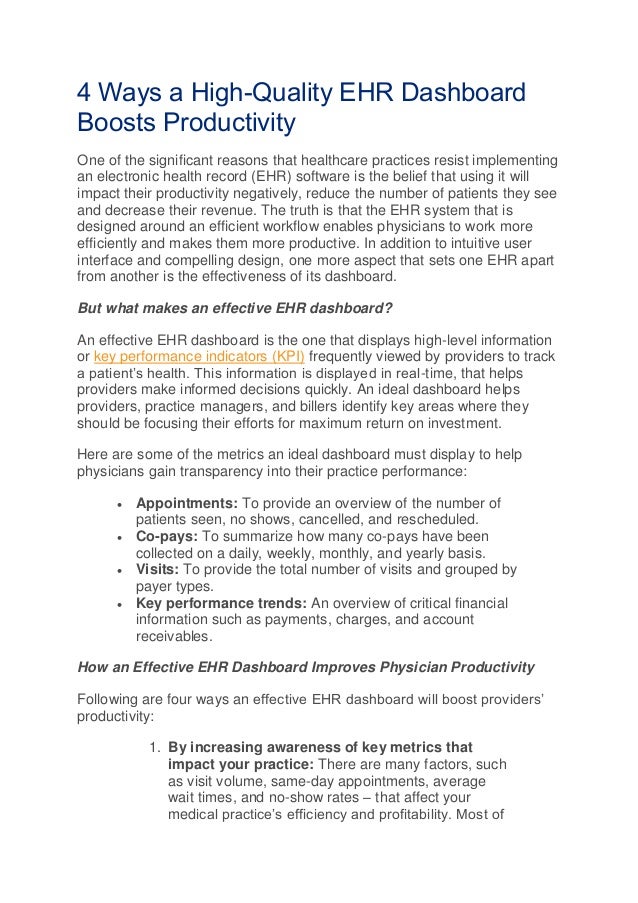
4 Ways a High-Quality EHR Dashboard Boosts Productivity
- 1. 4 Ways a High-Quality EHR Dashboard Boosts Productivity One of the significant reasons that healthcare practices resist implementing an electronic health record (EHR) software is the belief that using it will impact their productivity negatively, reduce the number of patients they see and decrease their revenue. The truth is that the EHR system that is designed around an efficient workflow enables physicians to work more efficiently and makes them more productive. In addition to intuitive user interface and compelling design, one more aspect that sets one EHR apart from another is the effectiveness of its dashboard. But what makes an effective EHR dashboard? An effective EHR dashboard is the one that displays high-level information or key performance indicators (KPI) frequently viewed by providers to track a patient’s health. This information is displayed in real-time, that helps providers make informed decisions quickly. An ideal dashboard helps providers, practice managers, and billers identify key areas where they should be focusing their efforts for maximum return on investment. Here are some of the metrics an ideal dashboard must display to help physicians gain transparency into their practice performance: Appointments: To provide an overview of the number of patients seen, no shows, cancelled, and rescheduled. Co-pays: To summarize how many co-pays have been collected on a daily, weekly, monthly, and yearly basis. Visits: To provide the total number of visits and grouped by payer types. Key performance trends: An overview of critical financial information such as payments, charges, and account receivables. How an Effective EHR Dashboard Improves Physician Productivity Following are four ways an effective EHR dashboard will boost providers’ productivity: 1. By increasing awareness of key metrics that impact your practice: There are many factors, such as visit volume, same-day appointments, average wait times, and no-show rates – that affect your medical practice’s efficiency and profitability. Most of
- 2. this information is captured by different individuals and stored on different machines or systems. Without a single platform, it would not be easy to view this information and make informed decisions. A useful dashboard provides a glance into this information and allows users to generate reports, just with a few clicks of the mouse. 2. By displaying user-specific information and not irrelevant data: When users log into the EHR software, they should see information specific to their roles, and not be inundated with unrelated numbers. Dashboards should instantly provide key information and analytics to keep the physician informed. For instance, a physician is more interested in seeing the number of patients coming in on a day, their co- payment information, and eligibility data to get an accurate view of what their day will look like. A practice manager wants to be able to view open tasks, patient portal messages that require a response, or insurance information that requires updates upon check-in. By displaying all the relevant information on one screen, a dashboard helps users stay efficient. 3. By consolidating financial and clinical information: Providers and practice managers need a consolidated view of financial and clinical data. This is where most EHR dashboards fall short as they include either clinical information or financial information, but not both on a single platform. A consolidated view helps users as it reflects the interconnection between departments and makes it easier to see what is and isn’t working and make strategic changes accordingly. 4. By increasing accountability: The only way to know what works and what does not is by tracking the progress. By monitoring parameters like patient satisfaction through the dashboard, decision-makers can reward providers who are delivering exceptional care to patients, arrange training for those who aren’t, and make staffing changes based on patients’ feedback. As the data is presented on the dashboard in an interactive and visual format, it is possible to absorb, analyze, and share key points with ease,
- 3. thus saving time and encouraging cross- departmental collaboration. Conclusion Despite having so many valuable features and offering benefits, an EHR dashboard is only as useful as the data flowing into it. Assuming the reliability of information is ensured, a dashboard designed with usability and efficiency in mind is a boon to physicians. It can help healthcare practices save time that they can reinvest into delivering quality care.
